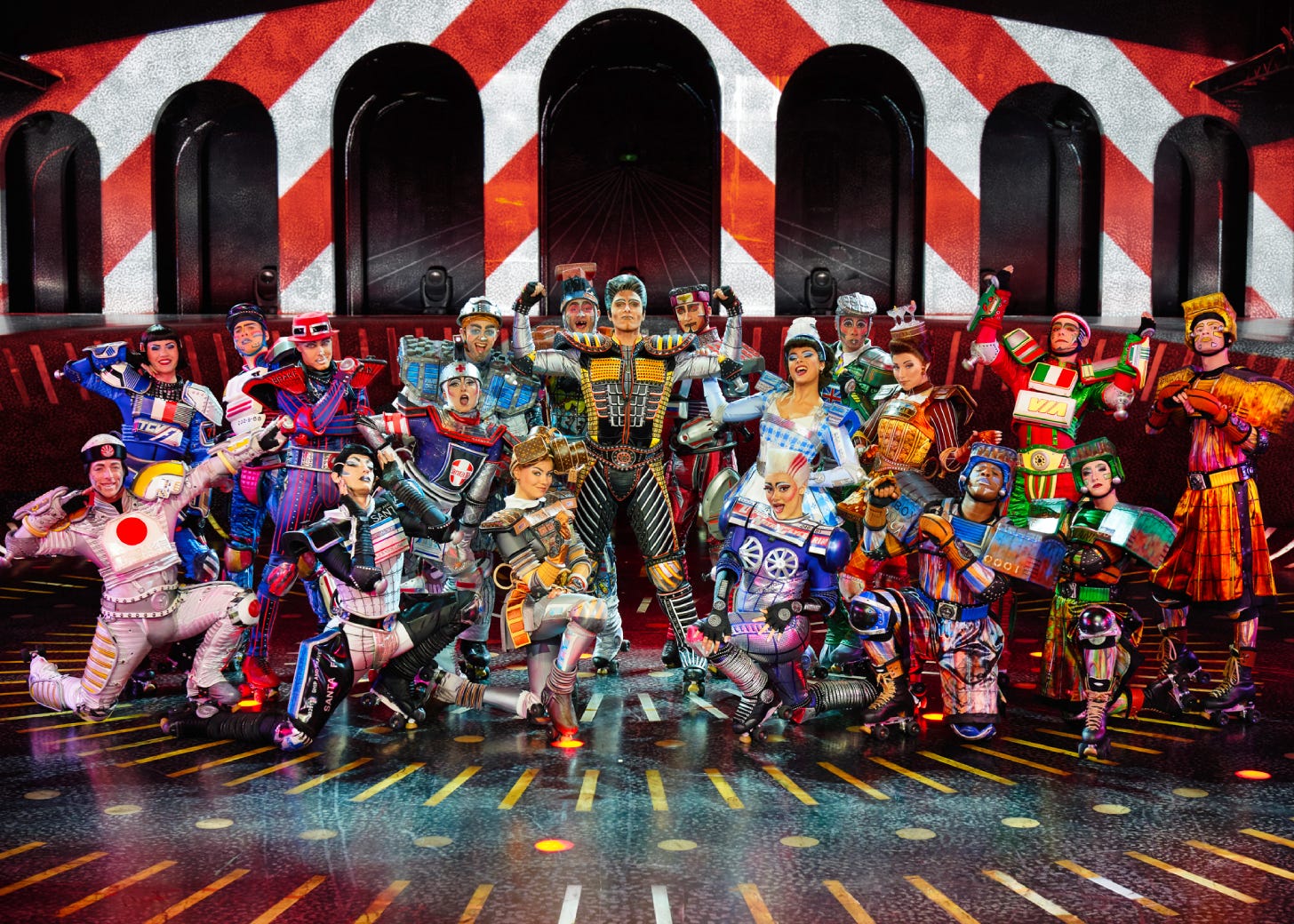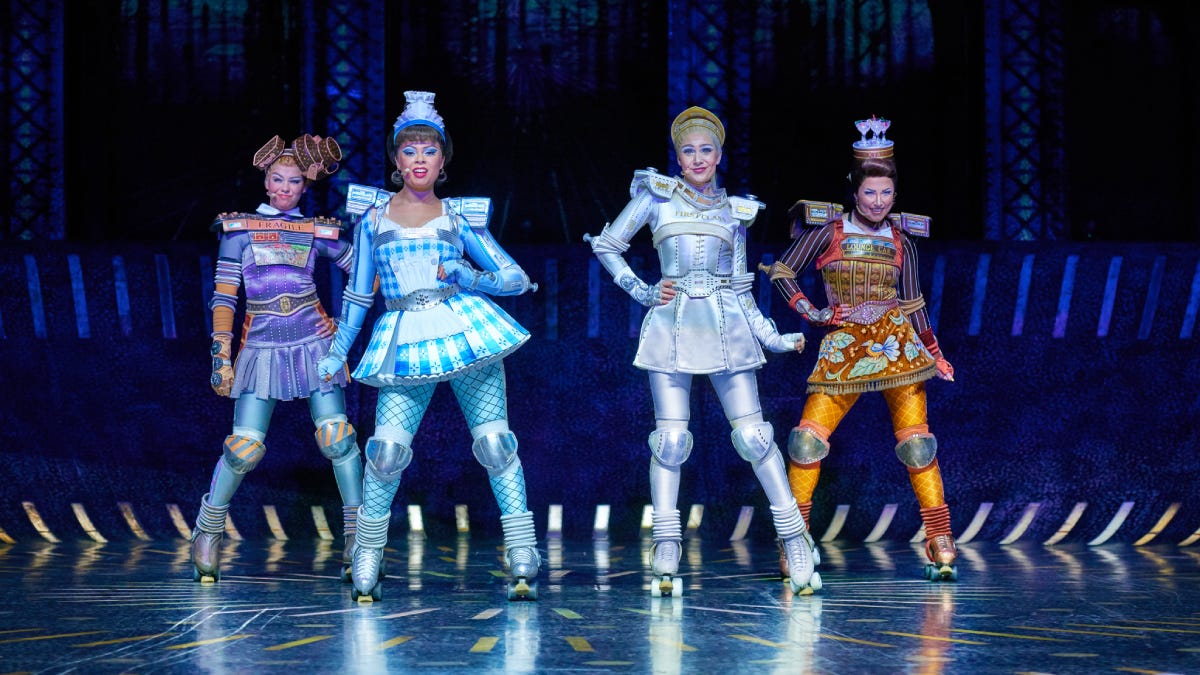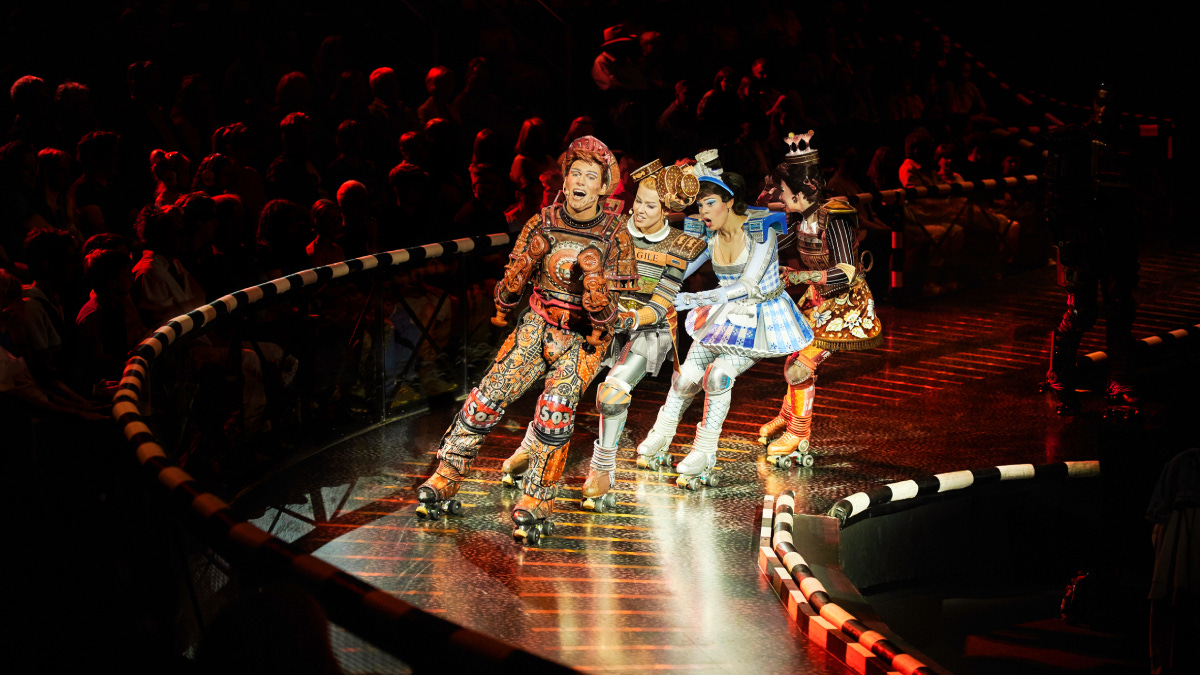How Andrew Lloyd Webber’s roller skating train musical has run for 35 years—and counting—in a German town you’ve probably never heard of

Hallo and welcome to Jaques, your weekly guide to the global theater industry. New to Jaques? Learn more here, and if you’re looking for the most recent edition of ABROAD/WAY BULLETPOINTS, my roundup of international theater headlines, it’s thisaway:
When I tell people the real reason I started this newsletter was to give myself an excuse to go to Germany to see Starlight Express, I’m only half kidding. And honestly, the surprising fact of the show’s status as Deutschland’s Phantom of the Opera—in a town that’s not Hamburg, the third largest musical theater market in the world—is one of the head-turning global success stories I’ve been most excited to dive into. This week: It’s finally happening. To celebrate I’m making this SPOTLIGHT STORY free for all readers.
Train for Bochum, now departing.
SPOTLIGHT: WHAT’S GERMAN FOR ‘GRAVY TRAIN’?
London, 1985: Pre-teen me sees Starlight Express on the West End and it blows my little adolescent mind.
So when, decades later, I interviewed the Lord himself—Lord Andrew Lloyd Webber—as part of Variety’s annual Broadway breakfast in October 2021, I finished our conversation with a question that I mentioned was very important to me personally. It boiled down to, “Starlight Express revival: When?”
He responded, “Can I ask you why it’s important to you personally?” Which I thought was a pretty graceful deflection from a creator who, as his subtext implied, wasn’t interested in devoting much brainspace to his nearly 40-year-old musical about roller skating trains. He said as much a moment later: “It was great fun in its time, but I really want to move on. I want to write something new.”
However, he did tell me: “You could go to Bochum and see it in Germany there. It’s in its own little stadium. It’s very good there now.”
I had heard vaguely of the German production (although if you had asked me I would have told you it was in Stuttgart), so I said off-handedly, “Oh, yeah, it’s been running there for years, right?”
Reader, it has been running there for 35 years. Technically, 35 and a half—which means it’s just surpassed the New York lifespan of The Phantom of the Opera, Broadway’s longest-running production ever. And it shows no sign of running off the rails anytime soon.
The story of how Starlight Express became a cultural touchstone in one of Germany’s lesser-known cities is the story of a big producorial swing, a unique site-specific opportunity and an early recognition of the tourism potential of large-scale musical theater.
In this SPOTLIGHT STORY, I’ll highlight:
-
how the show ended up in Bochum—and why it’s a perfect fit,
-
the dire first six months of the run and what turned it around,
-
a timeline of the surprisingly frequent revisions,
-
all the jaw-dropping stats you amass when your roller skating musical has been running for decades, and
-
the universal takeaways of the show’s Bochum success.
Let’s roll out.
ALL ABOARD
Even if Lloyd Webber had little interest in revisiting Starlight Express in 2021, producers clearly had other ideas. Two years after that Variety breakfast, in September 2023, Michael Harrison of Lloyd Webber Harrison Productions—the company behind the recent, buzzy revival of the composer’s Sunset Boulevard now on its way to Broadway—announced a new London production of Starlight Express launching this June.
Everyone involved is keeping mum for now, but we do know that it’ll happen in a specially designed “Starlight Auditorium” at Wembley Park Theater, with a creative team that includes director Luke Sheppard (& Juliet), set designer Tim Hatley (Back to the Future), projection designer Andrzej Goulding (Life of Pi), and costume designer Gabriella Slade (SIX). Ashley Nottingham provides new choreography with original choreographer Arlene Phillips on board as creative dramaturg, and Lloyd Webber promises a “big new plot twist.”
Over here in the States, it’s easy to think of Starlight Express as a short-lived cult artifact, largely because the Broadway import of the original production had a relatively brief lifespan of 22 months (1987-1989). But many New Yorkers—including this one—forget that on the West End the show ran for 17 years. Add that to its decades in Bochum and the string of tours through Asia, Australia, the U.S. and the U.K., as well as one-off runs around the world (Johannesburg, Mexico City, Vegas), and estimations of the show’s total earnings ring up at more than $1.4 billion.
Not bad for a musical that started life as a 1970s pilot for a Thomas the Tank Engine cartoon.
As a kid Lloyd Webber had loved The Railway Series, the books that introduced Thomas the Tank Engine, and soon after the release of the Evita concept album he began work on an animated adaptation. Voice and music tracks for the pilot were recorded in 1977, but by the next year the project was deemed too costly and too uniquely British to have any global appeal.1 (The separate, long-running series that proved otherwise, Thomas & Friends, didn’t premiere until 1984.)
Not long after, Lloyd Webber worked on an eccentric animated retelling of Cinderella in which Cinderella was a steam engine and the two ugly stepsisters were a diesel and an electric train, all competing for the chance to pull a prince in his royal carriage across the U.S. That one didn’t go anywhere either.
In both those projects you can see the beginnings of what would become the simple, family-friendly story of the musical, framed as a young boy’s dream about a sweet but obsolete steam engine named Rusty competing in a high-stakes series of races to impress a new observation car (later a first-class car) named Pearl. His Cinderella-style transformation comes when he gets a power-up from the mystical Starlight Express.
With Cats mania dawning on both sides of the Atlantic in the early 1980s, this incipient lark of an idea from Lloyd Webber and lyricist Richard Stilgoe exploded into the kind of mega-production that would become the composer’s signature. Set designer John Napier came up with the idea for the roller skates and designed a race track that wound through the theater and a bridge that spun 360 degrees. Directed by Trevor Nunn, the show’s 1984 West End debut at the Apollo Victoria Theatre rang in at a costly-at-the-time £2.25 million.
The Broadway production (with a cast that included Jane Krakowski and Andrea McArdle) didn’t recoup its $8 million capitalization costs over the course of its 22-month run, but that West End staging did just fine. It stuck around through 2002, with a 1992 overhaul that incorporated some significant creative changes from productions around world.
In 1988, the show rolled into Germany.
NEXT STOP BOCHUM
Back then, Germany wasn’t quite the musical-theater hotbed it is today. But according to David Savran, a CUNY professor and author of the new book Tell It To the World: The Broadway Musical Abroad, Germans in general had developed a fondness for Broadway-style musicals ever since local productions of Kiss Me, Kate and My Fair Lady caused a sensation in Berlin in the 1950s and 60s. By the 1980s, Hamburg hadn’t yet become the epicenter of the German musical theater business, but it already had one Lloyd Webber musical, Cats, going gangbusters there.
With Starlight in international-expansion mode—the U.S. road version, capitalized at $5 million, was described as “the most expensive touring show ever”—the producer of that German-language Cats, Friedrich Kurz, caught the show in London and wanted to bring it home.
But he faced a major hurdle. With its rich history of music, performance and opera, Germany had a robust inventory of theaters and opera houses nationwide—but at the time, nearly all of the large-scale venues were state-operated and government-subsidized, and none of them would have been keen to entirely remodel their buildings to accommodate an open-ended run of a show that the country’s cultural elite considered to be of questionable artistic value.
What Kurz needed was a brand new theater. To pay for it, he sought out municipal money—and found it in Bochum.
Located in northwestern Germany about 50 miles from the Dutch border, Bochum is part of a coal-rich region of the country known as the Ruhrgebiet (Ruhr area). It’s one of 50+ cities that sprang up in a cluster in the late 1800s to exploit local coal resources, and the region—which also includes the larger, better-known cities of Essen and Düsseldorf nearby—soon evolved into one of the nation’s most vital and populous centers of industry.
But the second half of the 20th century brought a decline in coal and mining that left the entire Ruhrgebiet struggling. Which explains why, in the mid 1980s, the city of Bochum was on the lookout for a tourist attraction that might boost the local economy.
IF YOU BUILD IT, THEY WILL COME… EVENTUALLY
Kurz and the city made a pact: Kurz would produce Starlight Express in Bochum, and in exchange, the city would pony up to construct a custom-built venue just for the show. It did, to the tune of 24 million Deutschmarks (a whopping $14 million in 1988 dollars).
It was, to say the least, a controversial use of taxpayer money.2 But on a plot of land conveniently located next to a highway exit, the Starlighthalle—a 1,650-seat venue with a track running in a ring through the middle and another weaving among pockets of seats toward the front of the house—was fast-tracked and swiftly built in about a year.

“Optimists thought that the show might run for four to five years,” recalls Meinolf Müller, the director of the Starlighthalle who’s been involved in the production since nearly the beginning. After the musical’s closing, he adds, “the idea was to change the interior of the building into a local town hall. Nobody expected that this show would run for ever.”
And early on, things didn’t look good. “The first six months were terrible,” Müller admits.
The turnaround came when the production’s promoters persuaded a long-running German TV sports newsmagazine, Das aktuelle Sportstudio, to film episodes live from the theater. The host, and some of the guests, were on skates.
The day after that first episode, Müller says, “the ticket hotline collapsed” from overwhelming demand. For the next five years the show was sold out months in advance.
Since then, it’s been sustained by a local and national affection for the musical. In fits right in with an area steeped in the history of industry, and in a town that has both a museum dedicated to trains and one to mining. Some 50% of audiences live less than 150 km (93 miles) from Bochum; the rest is filled out by theatergoers from other parts of Germany as well as international audiences from the Netherlands, Austria, Belgium, Switzerland and the U.K., among other countries.
“Starlight Express is one of the first wave of big musicals that really created the interest for many Germans in this art form, particularly as something commercial that had any financial value,” says Kevin Clarke, the German musicologist, curator and author of the book Breaking Free: Die wunderbare Welt des LGBTQ-Musicals (The Wonderful World of LGBTQ-Musicals).
There’s an elaborate production infrastructure to keep things going onstage, most notably the in-house training program and facilities for incoming actors. Performers work one-year contracts, and “Skate School” can last a grueling 16 weeks before a new cast rolls over into the production each year in late May or early June. Actors come from all over the world; the cast I saw in late 2023 included several performers from the U.K. and Australia.
A regular series of creative changes has also been made as revisions and new material from other productions have been incorporated over the years. (David Yazbek, the Tony-winning songwriter of The Band’s Visit, contributed new lyrics for touring versions of the show in the early 2000s.) By 2017, the production was so changed that a visit to Bochum prompted Lloyd Webber to give the show a creative overhaul in a workshop later that year, penning new material and updating many of the gender dynamics including switching the role of Poppa, an old steamer with a connection to the Starlight Express, to Momma.
Through it all, Starlight Express has stuck it out in Bochum long enough to become a family tradition.
“When I visit Starlight Express, it brings back memories that are precious. Memories of people I attended the show with or memories of my childhood,” says Marie Christin Trittschack, a 22-year-old superfan who has seen the show 15 times. “The experience is passed down through the generations.”
Bettina Koopmann, who saw Starlight the night I was there, brought along her 15-year-old daughter. A resident of Nordhorn (distance from Bochum: ~140 km), Koopmann had first seen the show with her parents in the 1980s, and had gone a second time as part of an early date with the man who is now her husband.
“It seemed to me like something people do with their families,” she says. As a youngster, she recalls being thrilled by the music and the immersive staging. “With the knowledge of today, I would not say it’s the greatest musical ever,” she adds. “But it’s still something that should be seen. And not only to see, it’s an experience.”
STARLIGHT, STAR BRIGHT: THE BOCHUM FACTS AND FIGURES
NUMBER OF CITIES IN THE RUHR REGION (1,712 SQ. MILES): 533
POPULATION OF THE RUHR: 5.1 million
TOTAL ATTENDANCE AT STARLIGHT EXPRESS SINCE 1988: 18 million
PERCENTAGE OF AUDIENCE FROM WITHIN 150 KM OF BOCHUM: 50%
ECONOMIC IMPACT OF STARLIGHT EXPRESS TOURISM: €60 million per year
STARLIGHTHALLE CONSTRUCTION COST, CIRCA 1988: 24 million Deutschmarks ($14 million in 1988 dollars)
OPENING NIGHT: June 12, 1988
TOTAL PERFORMANCES IN BOCHUM: 13,000+
TOTAL PERFORMERS OVER THE YEARS: 850
NATIONALITIES IN THE CAST: 27
ROLLER SKATES USED: 171,849 (and 189,361 shoelaces)
KNEE PADS WORN OUT: 13,867
METERS OF BAND-AIDS APPLIED TO MINOR INJURIES: 28,293 (17.5 miles)
CUES CALLED BY STAGE MANAGEMENT: 983,471

REROUTING AND DETOURS: A TIMELINE OF REVISIONS
1988
The show that opens in Bochum is largely based on the arena touring version created for the 1987 Japan and Australia tour, including a simplified story that reduces the number of train races to four (from the original five).
2002
Addition of the Trax, two stunt skaters (on inline skates, aka rollerblades) who perform tricks throughout the show.
2003
Creative changes incorporated from a major 1992 revision of the West End production. Three new songs are folded in, including the “Megamix” finale.
2007
Pyrotechnics added to the production’s SFX.
2013
Multiples changes from a 2012 UK tour incorporated, including the replacement of the song “Next Time You Fall in Love” with “I Do,” written by Lloyd Webber’s son Alastair.
2018
For the Bochum production’s 30th anniversary, a fresh overhaul brings in many of the revisions from the 2017 workshop at the Other Palace in London.
-
new costumes, orchestrations, lighting and sound design introduced
-
changes made to the overall gender balance, both in cast makeup and in character dynamics
-
the major character of Poppa, the wise old steam train, genderflipped to Momma
-
multiple songs moved around and rewritten
-
train names updated, including the Japanese train (now called Manga) and the U.K. train (renamed Brexit)
-
drones added to create new special effects
LAST STOP
I realize I can’t get off this train without answering a crucial question: Is Starlight Express… good?
Look, I dunno; it was in German. But it’s certainly true that even in a foreign language its roots as a simple children’s story are pretty evident, and plot doesn’t really seem the point. The show’s been described as “Cats with trains,” and from what I could tell, that’s not wrong.
Did I have a great time at a bonkers spectacle that exists nowhere else in the world (at least until that London production starts up)? I sure did.
The success of Starlight Express in Bochum seems such an anomaly that it can be hard to lift lessons from it that might be of value to readers in the industry sifting for clues to international success. Still, there are a few takeaways.
MUSICAL AS LANDMARK? BOCHUM GOT ON THAT TRAIN EARLY.
On Broadway, the longevity of The Phantom of the Opera eventually endowed the show with something akin to landmark status. It became part of the checklist for a visit to New York: See the Statue of Liberty; see the Empire State Building; see Phantom. By now The Lion King and Wicked have achieved similar prominence.
Back in the 1980s, it wasn’t so obvious that a musical could become a landmark with a massive economic impact. Bochum, then, made a bet that was ahead of its time—and it won them a €60 million annual boon to the local economy.
“People don’t go to Bochum because it’s such a nice place to visit,” Clarke says with a laugh. “It’s an ugly town in Ruhrgebiet. You go because you book the show, you get the pre-show dinner, you stay in the hotel, maybe you take the spa opportunity.”
TARGET THE RIGHT DEMO
Kurz knew Starlight Express was never going to win over his country’s high-art crowd, so he aimed wider—and took advantage of the fact that he was promoting one of the few musicals with even the remotest connection to sports. That sports-news showcase unlocked the audiences that have powered this locomotive for years.
IT NEVER HURTS TO KEEP THINGS FRESH
These days it’s not uncommon for a long-running show to incorporate the incremental changes instituted by the creative team in other productions around the world. Often these changes don’t draw much notice; for Starlight Express, though, a couple of the overhauls were major enough to give the show a publicity boost—and tempt back repeat viewers.
SOMETIMES A BIG SWING PAYS OFF
To Germans in the 80s, the prospect of spending 24 million Deutschmarks on Starlight Express—on the theater alone—must have seemed as unhinged as the ever-mounting price tag of Spider-Man: Turn Off the Dark did two decades later. Spider-Man, of course, became a prime Broadway example of the high cost of hubris, but Starlight Express serves as a reminder that sometimes it’s the wildest ideas that hit it big.
AND, OF COURSE: THE THEATER INDUSTRY IS A LOT BIGGER THAN 12 BLOCKS IN MIDTOWN MANHATTAN
The thesis of this newsletter as a whole is that the international theater business is so broad and varied that success can be found in some of the most unexpected places. That’s the story of Starlight Express in a nutshell, and it goes to show you can have a hit far, far beyond Broadway—which means that somewhere in the world, there might be a home for even a show that doesn’t draw crowds in New York.
Lloyd Webber recounts all this in his memoir Unmasked.
The details of this backstory are drawn from interviews with Starlighthalle director Meinolf Müller and musicologist Kevin Clarke, as well as from a rough translation of one section of Wolfgang Jansen’s German-language book Cats & Co.
Data compiled from local information resources, from interviews and from the production.



